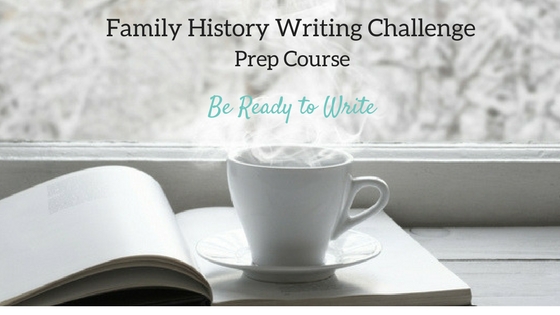- Create a daily target goal. It’s important to understand how much time you can dedicate to writing each day and how many words you can write in that timeframe. Do those targets coincide with your goal? You have to do the math and set realistic and expectations for yourself.
- Choose an Ancestor to write about. You can’t possibly write your entire family history in 28 days. However, you can choose one ancestor and one story that you can write about during these 28 days. Don’t overwhelm yourself. Start with one story, one ancestor.
- Take some time to get organized. Gather your research together and create a workflow. It’s important to get organized before you begin to write so that you actually spend your time writing and not looking for your research. You’ll be a much more productive writer and find the process that much more enjoyable.
- Complete an ancestor profile. Dig deep and learn as much as you can about your ancestor. The more you know, the more confident you will be about writing their story. A profile is a vital tool to fleshing out your ancestor and getting to know him or her in-depth. You’ll find an excellent ancestor profile in our workbook, The Authentic Ancestor.
- Create a timeline of your ancestor’s life. Timelines are fabulous tools to help you understand what you know, what you don’t and to help you find your story. Don’t miss this step.
- Identify your ancestor’s story? We don’t just want to tell a chronological tale of an ancestor’s life from beginning to end, that would be boring. Instead take the time to find your ancestor’s goals, motivations and the risks they took to meet their dreams.
- Understand scene and summary. Family history stories are written using the genre of narrative nonfiction. Narrative nonfiction uses scene and summary like building blocks to create a story. Make sure you understand this concept as it is at the core of writing your family history stories. It will also help you in creating your storyboard for your writing. Our workbook, Crafting a Scene is an excellent resource for learning scene and summary.
- Create a storyline. A storyline is like a timeline but different. It is the timeline for your story. Identify the key scenes that will carry the story and organize them into a storyline. A storyline will help you to create an entertaining and suspenseful tale that will pull your readers along. You can learn to create a storyline in our workbook, Finding the Story.
- Create a 4-week storyboard. A storyboard is your map for writing. Using index cards, you can outline your storyboard using scenes. Once you create your storyboard, it will serve as a great visual reminder of your writing plan, day by day. A storyboard will keep you focused and on track. Want to learn more about storyboards consult Crafting a Scene.
- Create a daily schedule and your writing place. Make sure you plan your writing and make it a priority, at least, for the next 28 days. Also, you need to identify a place for writing, a desk or table, you can claim as your writing space. These are essential steps to completing the Challenge with success and making it a priority for the next 28 days.
If you want to meet with success this year, you need to make writing your family history stories a priority, and you need to come with a plan. We cover all 10 of these steps in detail with worksheets in our Family History Writing Challenge Prep Course.
This year, score big in the Family History Writing Challenge. Be ready to write.

